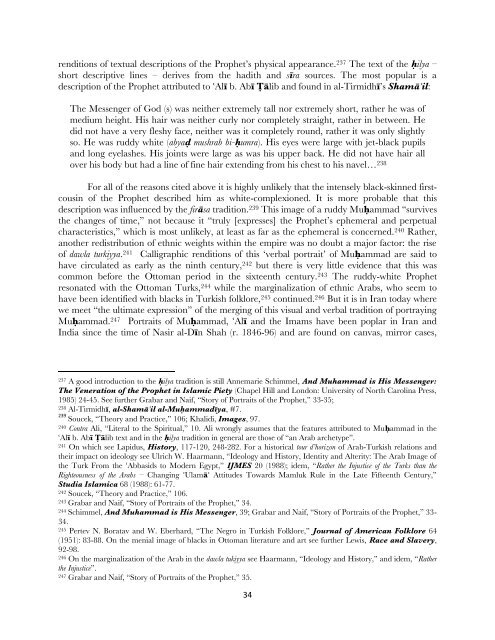Muhammad_Article.349.. - Dr. Wesley Muhammad
Muhammad_Article.349.. - Dr. Wesley Muhammad
Muhammad_Article.349.. - Dr. Wesley Muhammad
Create successful ePaper yourself
Turn your PDF publications into a flip-book with our unique Google optimized e-Paper software.
enditions of textual descriptions of the Prophet’s physical appearance. 237 The text of the Èilya –<br />
short descriptive lines – derives from the hadith and sÊra sources. The most popular is a<br />
description of the Prophet attributed to #AlÊ b. AbÊ •§lib and found in al-TirmidhÊ’s Sham§"il:<br />
The Messenger of God (s) was neither extremely tall nor extremely short, rather he was of<br />
medium height. His hair was neither curly nor completely straight, rather in between. He<br />
did not have a very fleshy face, neither was it completely round, rather it was only slightly<br />
so. He was ruddy white (abya∙ mushrab bi-Èumra). His eyes were large with jet-black pupils<br />
and long eyelashes. His joints were large as was his upper back. He did not have hair all<br />
over his body but had a line of fine hair extending from his chest to his navel… 238<br />
For all of the reasons cited above it is highly unlikely that the intensely black-skinned firstcousin<br />
of the Prophet described him as white-complexioned. It is more probable that this<br />
description was influenced by the fir§sa tradition. 239 This image of a ruddy MuÈammad “survives<br />
the changes of time,” not because it “truly [expresses] the Prophet’s ephemeral and perpetual<br />
characteristics,” which is most unlikely, at least as far as the ephemeral is concerned. 240 Rather,<br />
another redistribution of ethnic weights within the empire was no doubt a major factor: the rise<br />
of dawla turkiyya. 241 Calligraphic renditions of this ‘verbal portrait’ of MuÈammad are said to<br />
have circulated as early as the ninth century, 242 but there is very little evidence that this was<br />
common before the Ottoman period in the sixteenth century. 243 The ruddy-white Prophet<br />
resonated with the Ottoman Turks, 244 while the marginalization of ethnic Arabs, who seem to<br />
have been identified with blacks in Turkish folklore, 245 continued. 246 But it is in Iran today where<br />
we meet “the ultimate expression” of the merging of this visual and verbal tradition of portraying<br />
MuÈammad. 247 Portraits of MuÈammad, #AlÊ and the Imams have been poplar in Iran and<br />
India since the time of Nasir al-DÊn Shah (r. 1846-96) and are found on canvas, mirror cases,<br />
237 A good introduction to the Èilya tradition is still Annemarie Schimmel, And <strong>Muhammad</strong> is His Messenger:<br />
The Veneration of the Prophet in Islamic Piety (Chapel Hill and London: University of North Carolina Press,<br />
1985) 24-45. See further Grabar and Naif, “Story of Portraits of the Prophet,” 33-35;<br />
238 Al-TirmidhÊ, al-Sham§"il al-MuÈammadÊya, #7.<br />
239<br />
Soucek, “Theory and Practice,” 106; Khalidi, Images, 97.<br />
240 Contra Ali, “Literal to the Spiritual,” 10. Ali wrongly assumes that the features attributed to MuÈammad in the<br />
#AlÊ b. AbÊ •§lib text and in the Èilya tradition in general are those of “an Arab archetype”.<br />
241 On which see Lapidus, History, 117-120, 248-282. For a historical tour d’horizon of Arab-Turkish relations and<br />
their impact on ideology see Ulrich W. Haarmann, “Ideology and History, Identity and Alterity: The Arab Image of<br />
the Turk From the #Abbasids to Modern Egypt,” IJMES 20 (1988); idem, “Rather the Injustice of the Turks than the<br />
Righteousness of the Arabs – Changing #Ulam§" Attitudes Towards Mamluk Rule in the Late Fifteenth Century,”<br />
Studia Islamica 68 (1988): 61-77.<br />
242 Soucek, “Theory and Practice,” 106.<br />
243 Grabar and Naif, “Story of Portraits of the Prophet,” 34.<br />
244 Schimmel, And <strong>Muhammad</strong> is His Messenger, 39; Grabar and Naif, “Story of Portraits of the Prophet,” 33-<br />
34.<br />
245 Pertev N. Boratav and W. Eberhard, “The Negro in Turkish Folklore,” Journal of American Folklore 64<br />
(1951): 83-88. On the menial image of blacks in Ottoman literature and art see further Lewis, Race and Slavery,<br />
92-98.<br />
246 On the marginalization of the Arab in the dawla tukiyya see Haarmann, “Ideology and History,” and idem, “Rather<br />
the Injustice”.<br />
247 Grabar and Naif, “Story of Portraits of the Prophet,” 35.<br />
34

















